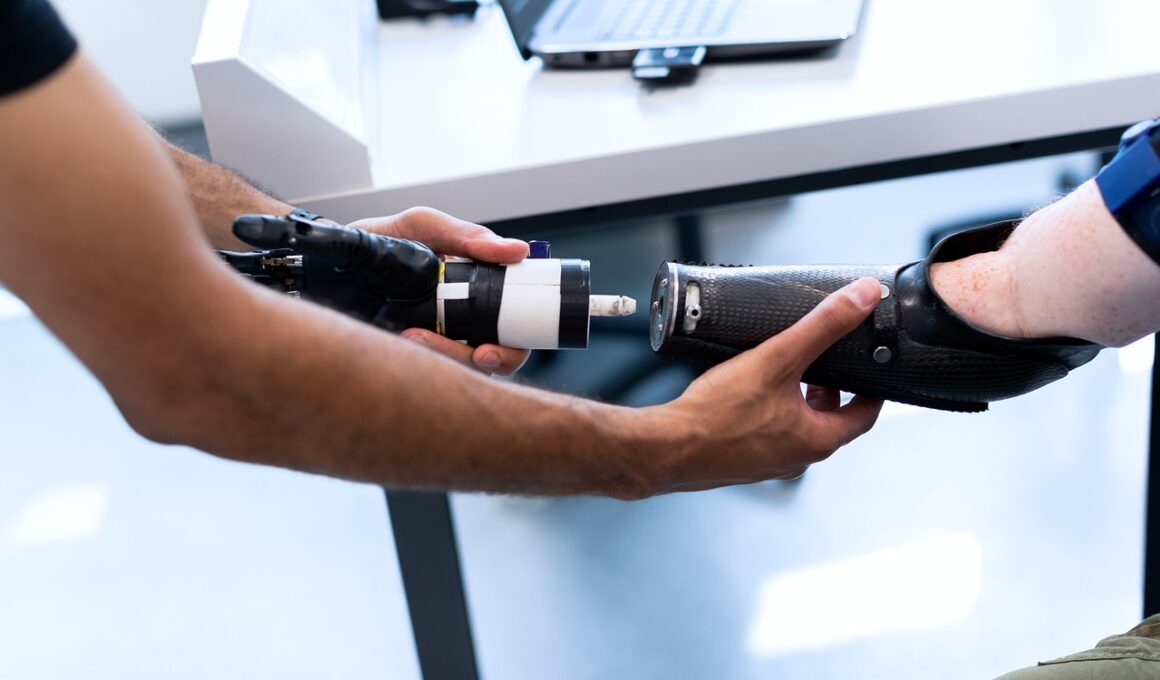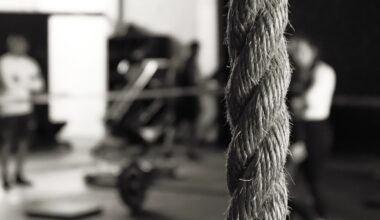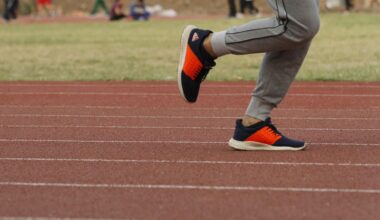Innovations in Prosthetics and their Impact on Adapted Physical Activity
Prosthetics technology has significantly advanced in recent years, leading to more functional and comfortable devices for individuals with disabilities. The incorporation of lightweight materials and smart technology has revolutionized the user experience, allowing more personalized adjustments. For example, prosthetic limbs now utilize sensors that recognize the user’s movement intentions, facilitating smoother and more natural motions. Manufacturers continually aim to enhance the aesthetics of prosthetics, allowing users to feel more confident. Innovations such as 3D printing enable customizations that were once impossible, matching aesthetics to the individual’s lifestyle. This technological integration not only fosters independence but also enhances participation in adapted physical activities, promoting healthier lifestyles. Users can engage more fully in sports and recreational activities that were once seen as challenging or uncomfortable. Moreover, this has driven awareness in society, shifting perspectives toward inclusivity and the capabilities of individuals with prosthetic limbs. We see adaptive sports programs emerging which cater specifically to these advancements in prosthetic technology and encourage engagement. Thus, the synergy between advanced prosthetic technology and adaptive physical activities creates opportunities for a more active lifestyle, making it vital in contemporary society.
One area where advancements in prosthetics have had a profound impact is in sports. Adaptive sports have evolved tremendously, thanks to improved prosthetic devices that offer better performance. Athletes with prosthetics are now participating in competitions at levels never seen before. Among these, track and field events have become particularly popular, with participants using advanced running blades designed for optimal speed and agility. These blades allow for the mimicry of natural running mechanics, drastically improving athletes’ performances. Similarly, wheelchairs have been engineered for competitive basketball, racing, and other sports, optimizing functionality and comfort. The design of these wheelchairs includes lightweight materials and specialized wheels, ensuring excellent maneuverability and speed. In addition, innovations such as artificial intelligence are beginning to be integrated into prosthetics. AI can analyze movements and provide real-time feedback to users. Such technology enhances training regimes, allowing for better performance and reducing the risk of injury. Consequently, individual athletes, teams, and communities benefit from these developments. They not only increase inclusiveness but also inspire other individuals to engage in physical activities, showcasing the immense potential of advanced prosthetic technology.
The Role of Rehabilitation Professionals
Rehabilitation professionals play a crucial role in maximizing the use of advanced prosthetics. Their expertise ensures that individuals receive tailored support, shaping the rehabilitation journey based on personal needs and goals. Physiotherapists, occupational therapists, and prosthetists work collaboratively throughout this process. Initially, they assess the individual’s requirements, taking into account physical capabilities and ambitions. They guide patients through strength training and mobility exercises, pivotal for optimal adaptation to their new limbs. Additionally, integrating mental and emotional support enhances confidence levels, which often correlate with successful adaptation. Many individuals face psychological barriers when transitioning to the use of prosthetics. Consequently, these professionals emphasize fostering positive relationships and encouraging self-efficacy. The holistic approach typically yields stronger results, enabling patients to engage more actively in adapted physical activities. On the other hand, these specialists remain up-to-date with the latest prosthetic innovations, ensuring they can provide informed recommendations. Clinics may offer trial sessions, exposing patients to different types of prosthetics. Therefore, professionals who specialize in rehabilitation are integral to empowering individuals with advanced prosthetics to succeed and thrive in their chosen activities.
Inclusivity in sports and physical activities has seen a marked improvement because of advancements in prosthetic technology. Historically, athletes with disabilities faced numerous barriers, both societal and physical. Now, there are more opportunities for participation, leading to a larger community of active individuals. Schools and organizations are increasingly recognizing the importance of adapted sports programs. These efforts aim to foster collaboration between those with and without disabilities, building unity and understanding. Various initiatives have arisen, providing not only resources but also events catered specifically to adaptive sports. For example, community sporting events may include wheelchair basketball tournaments or running competitions for individuals with various types of prosthetics. However, while participation is increasing, it is crucial to cultivate awareness around the complexities and needs of individuals who rely on technology. Prominence in adapted sports can change perceptions, showcasing the strengths, capabilities, and athleticism of these individuals. Such narratives inspire positive engagement from audiences and promote inclusivity. Therefore, advancements in prosthetic technology serve as a catalyst for change, reshaping the landscape of adapted physical activities and extending the reach of possibilities available to everyone.
Future Innovations in Prosthetics
Looking ahead, the future of prosthetics is incredibly promising. Researchers are exploring groundbreaking solutions that could redefine the boundaries of functionality. Innovations like biofeedback systems are emerging, allowing prosthetics to respond to brain signals directly. This synergy may lead to more intuitive control, enabling users to maneuver their prosthetics purely through thought. Furthermore, science is delving into the field of robotics, leveraging soft robotics to create prosthetics that mimic human muscle behavior. Such advancements could revolutionize the user experience, allowing a previously unseen range of motion and dexterity. Additionally, wearable technology continues to evolve, potentially integrating with smartphone applications and smart devices, enhancing interactivity and feedback. Adaptive learning capabilities may allow prosthetics to adjust based on environmental changes, providing users with a customizable experience. Thus, as technology and science continue to push boundaries, the role of advanced prosthetics in adapted physical activity will undoubtedly progress positively. Collaboration between medical professionals, engineers, and users will be pivotal in bringing these futuristic ideas to reality, ensuring the focus remains on improving quality of life.
The impact of innovations in prosthetics extends beyond physical capabilities; they also serve to challenge societal perceptions about disability. As athletes showcase their abilities in sports arenas, the dialogue around disability evolves. Public figures participating in events such as the Paralympics play a crucial role in breaking down stigma and showcasing excellence. The heightened visibility of individuals with prosthetics amplifies the need for inclusive environments, not just in sports but across various platforms. Furthermore, media plays a significant role in reshaping narratives surrounding disability. Positive coverage fosters greater awareness, acceptance, and ultimately encourages adaptive participation in all areas of life. Educational institutions are beginning to adopt curricula that include lessons on inclusivity, creating awareness from an early age. This foundational understanding lays the groundwork for future generations, reinforcing the value of diverse experiences. Moreover, community outreach programs are fostering partnerships between individuals with disabilities and mainstream initiatives. Such collaborative efforts will lead to more inclusive environments, paving the way for conversations around equity and access to health and fitness. Consequently, the journey toward societal inclusion remains intertwined with advancements in prosthetic technology.
Conclusion: Transforming Lives through Advanced Technology
In conclusion, the intersection of innovative prosthetic technology and adapted physical activity represents a transformative force in society. This synergy not only fosters independence but also inspires a greater level of participation in diverse activities. The ongoing advancements highlight the commitment to improving the quality of life for individuals with disabilities. Enhanced performance possibilities in sports manifest societal shifts toward inclusivity, breaking barriers that previously existed. As prosthetic technology influences existing and emerging recreational practices, the landscape of adapted physical activity will continue to evolve positively. Furthermore, educational initiatives and advocacy efforts will remain essential in broadening perspectives and ensuring acceptance. Future collaborations between various fields will prioritize the individual’s needs as new technologies are developed. Ultimately, the narrative surrounding disability is being rewritten through the lens of capability rather than limitation. With each innovation, the horizons broaden for individuals using prosthetics seeking an active lifestyle. By focusing on empowering experiences and inclusive environments, society moves closer to a future where barriers are eliminated, paving the way for everyone to participate meaningfully in all aspects of life.
Technological advancements drive a continuous improvement cycle in prosthetics, promoting user engagement and intersectionality with adapted physical activities. It is essential to remain cognizant of the ethical implications of these developments, including accessibility and cost. Societal structures must evolve alongside technology to ensure equitable access to resources for individuals seeking participation in adapted sports. Continued dialogue among stakeholders—including manufacturers, healthcare professionals, athletes, and the community—will facilitate a more comprehensive understanding of user needs and technological capabilities. Future developments must maintain a user-centric approach to ensure that the advancements in prosthetics are equitable and beneficial for every unique user. Enhanced accessibility and understanding will fuel enthusiasm for participation and encourage diverse communities. In this light, holding the space for conversations around innovation, societal perceptions, and adaptations remains pivotal. The dynamic intersection of technology and community must carry forward with an understanding of the multifaceted influences at play. Ultimately, the journey toward inclusivity thrives on collaboration, development, and advocacy, ensuring that the future landscape of adapted physical activity remains bright and welcoming for everyone, regardless of their abilities.


